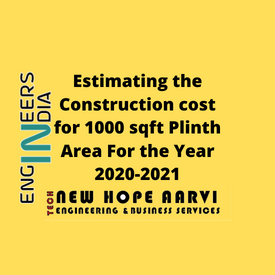Estimating the Construction cost for 1000 sqft Plinth Area

Estimating the Construction cost for 1000 sqft Plinth Area For the Year 2020-2021 Hello, friends today we are going to see how to estimate the construction cost for a 1000 Sqft plinth area for the year 2020-2021. Before going to proceed towards the process for the estimation, we are going to know the thumb rules which will be helpful for us to identify the construction cost. Construction cost per unit as per the classification of the construction type Table - 1 Thumb Rule - % wise role of various construction components on the total costing of the construction Table - 2 Estimating the Construction cost for 1000 sqft Plinth Area We are going to estimate the construction cost for Class-B Type Construction with minimum rates as shown in Table 1 (Estimating with Minimum Const. Rates per Unit | Class B Type) Table - 3 Now we have seen that as per Table - 1, for Class B Type Construction and for 1000 Sqft area we required around Rs.11,00,000.00 for construction. Moving further towards the e











